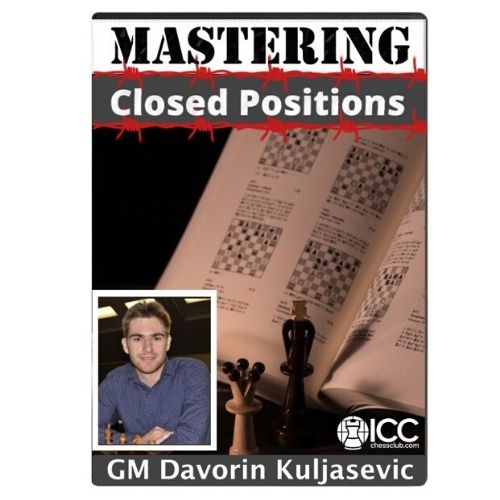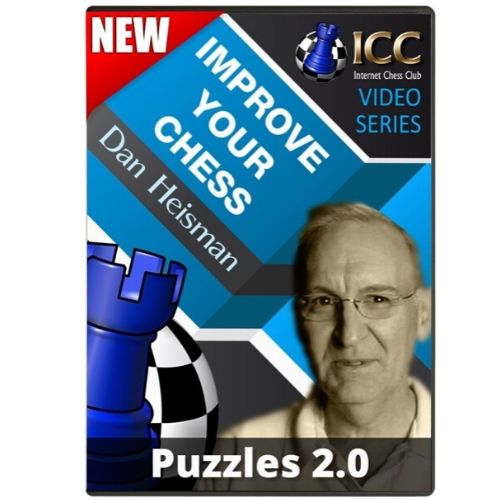Dan Heisman is considered one of the most original and influential modern chess tutors, thanks to his clear-cut approach to improvement and his celebrity students including radio personality Howard Stern. Now, for the first time, you can get all of Dan’s lessons in one 49+ hour pack, “Essential Dan Heisman: From A to Zugzwang”.
Essential Dan Heisman From A to Zugzwang and Endings Bundle
Dan Heisman is considered one of the most original and influential modern chess tutors, thanks to his clear-cut approach to improvement and his celebrity students including radio personality Howard Stern.
Dan’s award-winning articles, books, and video lectures have helped thousands of players better understand the game they love and achieve their chess ambitions. Phrases like “hope chess” have become part of improvers’ vocabulary, drawing attention to a problem many were unaware of before.
Now, for the first time, you can get all of Dan’s lessons in one 49+ hour pack, “Essential Dan Heisman: From A to Zugzwang”.
As the name suggests, this is a complete course covering every area of the game and every skill you need for success at the board.
There are 4 main sections:
- Tactics and Safety – how to avoid tactical blunders, even small or advanced ones, and capitalize on your rival’s mistakes. We all understand how important tactical ability is in chess, now Dan actually gives a step-by-step program for both improving pattern recognition and our analytical powers.
- Thought Process – probably the most important skill for players under 2200 and the topic Dan Heisman has become most famous for. How should we think on the board? We have a limited amount of time and have to consider tactics, pawns structure, create a plan, work out what our opponent is up to and find a way to stop it. From playing “real chess” to understanding non-analytical positions, Dan provides techniques for getting rid of bad habits and replacing them with good ones.
- Openings and Tabiyas – tabiyas are common chess positions, often reached in popular openings. Dan teaches that it’s more useful to know what to do in these positions and why than just memorizing a series of moves. 29 different lessons explain the ideas behind the Sicilian Najdorf, King’s Indian Defense, French Defense, Ruy Lopez/Spanish and many more.
- Endings – up to master level there are only a small number of endgames you need to know. Dan Heisman explains them all here. From triangulation and zugzwang to the Philidor and Lucena positions, this is essential knowledge that will repay you in tournament points.
Chess Endings
NM Dan Heismantackles the classics here, including the Lucena position and Pawn endings, but in this really useful series Dan also focuses his attention on several different subjects, such as Zugzwang, pawn promotion, technique, the all-important 7th rank, and more. And NM Heismans gives examples taken from amateur games, which illustrate brilliantly how the club player normally deals with endgames, and how it is possible to improve!
Included Products:
Thought Process and General Improvement.
- Introduction to Pawns
- Introduction to Thought Process
- Thought Process (2): Analytical and Non-Analytical Positions
- Theory of Chess Improvement
- Introduction to Time Management
- Evaluation Criteria
- Common Evaluation Misconceptions
- Break Moves
- Guide to P-R3
- The 20-minute Exercise
- The Maung Lesson
- Introduction to Mobility and Activity
- It’s a Different Game When You’re Way Ahead
- More pawns in the middle are good
- The margin for error
- Strategy Based on Central Pawn Structure
- Examples of Chess Logic
- A key part of the Thought Process
- 20-minute Exercise #2
- The Most Important Strategic Decisions
- Dan vs Computer: Live & Verbalized
- Avoid the Common Quiescence Error
- Dan vs. Computer #2 – Slower Game (Part 1)
- Dan vs. Computer #2 – Slower Game (Part 2)
- The 3 Types of Chess Vision
- Initial and Final Candidate Moves
- 20 Minute Exercise #3
- Dan vs Computer #3 – Part 1
- Dan vs Computer #3 – Part 2
- Identifying Candidate Moves
- 20-minute exercise #4
- Dan vs. Computer #4 (Part 1)
- Dan vs. Computer #4 (Part 2)
- Pawns: Majority Rolls and Bishops in the Opening
- Using Computer Engine to Analyze on ICC
- 20-minute exercise #5
- The mythical Capture with the Least Valuable Piece principle
- Hope Chess, Hand-Waving, and Acquiescing
- Special 64th Birthday: 4 Problems
- 20-minute exercise #6
- An overview of “Planning”
- 20-minute exercise #7
- Move by Move chess Book Series
Tactics and Safety.
- Introduction to Safety and Counting
- Is It Safe?
- The Seeds of Tactical Destruction
- Tempos and Threats
- Removal of the Guard
- The Loman Series*
- When is a King Safe?
- The Safety Table
- Five Ways to Make A Piece Safe
- AWL: Attack it with something Worth Less
- Invisible Moves and Sneaky Pins
- Finding Combinations in Games and Puzzles
- Pattern Recognition is NOT Sufficient
- Finding Tactics in Puzzles and Games
- Defensive Tactics
Openings
- Learning Tabiyas: The Closed Ruy Lopez
- Tabiyas 2: King’s Indian Defense Main Line
- Tabiyas 3: Sicilian Dragon, Yugoslav Attack
- Tabiyas 4: Two Knights Defense: Fried Liver/Lolli
- Tabiyas 5: Sicilian Sveshnikov
- Using Openings to Improve
- Tabiyas 6: French Winawer
- Tabiyas 7: Sicilian Najdorf
- Tabiyas 8: Slav Defense
- Tabiyas 9: Open Ruy Lopez
- Queen’s Gambit Declined & Slav Defenses
- Tabiya 10: French Defense (Tarrasch Variation)
- Tabiyas 11: Avoiding the Exchange Gruenfeld
- Tabiyas 12: The Trappy Cambridge Springs Defense
- Tabiya 13: Queen’s Gambit Accepted
- Tabiya 14 – g3 English
- Gambit Overview
- Teach Me Something About Openings
- Tabiya 15 – Qc2 (Classical) Nimzo-Indian
- The Most Common Opening Inaccuracies
- Tabiya 16 – Caro Kann, Classical Variation
- Learning Opening Tactics with The Winning Way
- 1900 Plays Fast and Suffers Upset
- Beginner Opening Overview
- Tabiya 17 – Giuoco Piano
- Tabiya 18 – Modern Benoni Classical Variation
- Tabiya 19 – Sicilian Four Knights
- Tabiya 20: 2.c3 Sicilian Overview
- Riga Variation Fun
Endings
- King and Pawn vs. King (1)
- King and Pawn vs. King (2)
- King, Pawn and? vs King
- Queen vs. Pawn on the 7th Rank
- Rook vs. Connected passed pawns
- King and Two Pawns vs. King and Pawn
- Instructive Amateur King and Pawn Endgame
- Trading Pawns When Ahead
- King and Pawn vs. King and Pawn
- Endgame Techniques
- The Real and Mythical Outside Passed Pawn
- Just One -Easy- Recapture in the Deep Endgame
- Zugzwang
- Philidor and Lucena
- Solving an Endgame Puzzle
- Technique: King and 5 pawns vs King and 4 pawns
- Trebuchet and Friends
- Pawn Promotion or…?
- Tic-Tac-Toe and Dance-Around
- Beyond the 3-Pawn Endgame Trick
Endings Bundle
- 3-pawn vs 3-pawn endgame trick
- Amateur King and pawn endgame 1 (Sample game)
- Amateur King and pawn endgame 2 (Sample game)
- Another instructive endgame (Sample game)
- Another quick badly played endgame
- Critical King and pawn endgame moves played instantly (Sample game)
- Dance around (King and pawn endings)
- Endgame advantage fades to loss (Sample game)
- Endgame puzzle (Sample game)
- Endgame see-saw (Sample game)
- Endgame study neglected with fast play (Sample game)
- Endgame Technique
- Endgame turnaround (Sample game)
- Exciting opening and endgame (Sample game)
- Instructive King and pawn ending (Sample game)
- Just One -Easy- Recapture in the Deep Endgame (Sample game)
- Rook vs connected passed pawns
- Silly mistakes lead to instructive endgame (Sample game)
- Tactical rook and pawn ending (Sample game)
- The real and mythical outside passed pawn
- tough rook and pawn endings not held (Sample game)
- Trading pawns when ahead
- Trebuchet (king and pawn endings)
- Zugzwang
- King + 5 pawns vs King + 4 pawns
- King + pawn + other vs King
- King + pawn vs King + pawn
- King + two pawns vs King + pawn
- King and Pawn vs King 1
- King and Pawn vs King 2
- Pawn and king endgames are tricky (Sample game)
- Pawn promotion or …
- Philidor and Lucena
- Queen vs Pawn on the 7th rank
- Quick endgame moves turn to win intro draw into a loss (Sample game)









